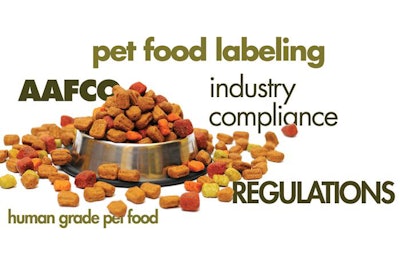
There has been a whirlwind of changes to United States pet food labeling requirements in the recent past, with more to come soon as well as further down the road. Most of these changes stem from actions by the Association of American Feed Control Officials (AAFCO). Add to that all the new processing, record-keeping and other requirements being implemented under the US Food and Drug Administration's (FDA) Food Safety Modernization Act, and it's easy to see how the pet food regulatory professional is keeping busy.
"Resolved" issues: what the pet food industry needs to know about compliance
After years of deliberation, a number of important amendments to the rules have been settled, so the job now is for pet food manufacturers to incorporate the required changes into their labeling. The revisions to the AAFCO Dog and Cat Food Nutrient Profiles became effective in January 2016. All new products must now be compliant, but products on the market prior to January 2016 must bear revised labeling by January 2018. Among the biggest changes (for dog foods, anyway) is the need to differentiate products based on maximum calcium content. Those products intended for "all life stages" or "growth" must specify whether it expressly includes or excludes suitability for large-breed puppies. For both dog and cat foods, the new profiles also change how specific fatty acids, such as DHA, appear in the guaranteed analysis.
Also, the grace period for enforcement of the amended AAFCO calorie content statement regulations has now expired. All pet foods, including treats, supplements and non-exempt chews, must now bear a calorie content statement in accordance with AAFCO methodology and format.
At the federal level, FDA released written guidance on the labeling and distribution of therapeutic petfoods in 2016. Essentially, these products must be distributed by or on the order of a veterinarian, with very limited information as to intended use allowed on the label or in promotional materials reaching the consumer. Further, they must otherwise conform to AAFCO/FDA requirements for all pet foods in terms of labeling and formulation. Actually, this policy doesn't deviate significantly from FDA's stance over the past several decades. The difference now is that because it is in written form, the circumstances under which the agency will accept these products on the market are clearer to state regulators and the industry.
Almost there: ongoing regulatory work nearing resolution
AAFCO finalized its definition and guidance for making "human grade" claims on pet food labels in 2016. However, while there is considerable interest in pursuing such claims within the industry, the ability to fulfill the requirements set forth in the guidance are proving difficult. It's not because of lack of availability or willingness to use human-edible ingredients, but rather being able to document that the processing conforms to human food standards. There are actually more hoops to jump through to prove your pet food is human grade than there are for human food facilities to document compliance with the rules! Work to facilitate documentation is ongoing.
After many years of deliberation and a few false starts, efforts to allow for some carbohydrate-related claims on dog and cat food labels may be coming to fruition. As accepted by the AAFCO Pet Food Committee, new regulations would allow for maximum guarantees for dietary starch and sugars based on validated testing methods. This would provide a means to allow the consumer to compare non-structural carbohydrate content of pet foods. A few more procedural steps within AAFCO and pet food companies can start making meaningful claims.
The work to revise AAFCO's policy with regard to dental-related claims is almost complete, as well. The major difference compared to what is on the books now is that the means by which the pet food product exerts its effect on dental health (i.e., mechanical vs. chemical) must now be clearly expressed on the label.
More changes to come: the future of pet food labeling regulation
Now that many of the labeling issues that have hounded the industry and regulators alike for years have been clarified, AAFCO is exploring a radical deviation from the current labeling format. Concerted efforts are going into "pet food labeling modernization." This may entail significant changes to how ingredients, nutritional adequacy statements, feeding directions and handling/safety instructions are declared on the label. Perhaps the biggest divergence would occur with respect to the nutrient content information, with replacement of the guaranteed analysis and calorie content statements with something akin to the "Nutrition Facts Box" that currently appears on labels of food for human consumption. While work is proceeding at a concerted pace (at least relative to most AAFCO activities), it will very likely take years before any new requirements are ever implemented.
While AAFCO has had a working definition and guidance for "natural" pet foods for decades now, FDA is just getting into the game. Although FDA is only contemplating new regulations around the use of the term for foods for human consumption, it's hard to ignore the possibility that any new rules may affect pet foods as well. Factors such as use of pesticides or inclusion of genetically engineered ingredients, not currently considered as applicable to the current AAFCO definition, may become additional considerations.
The latest on pet food regulations
















